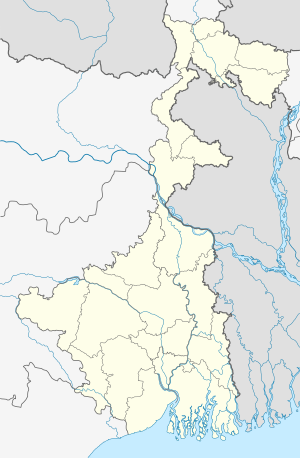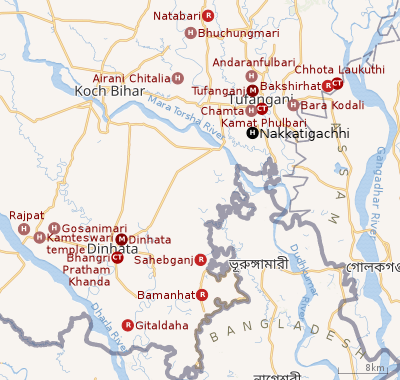Nakkatigachhi
Nakkatigachhi is a village in the Tufanganj I CD block in the Tufanganj subdivision of the Cooch Behar district in West Bengal, India
Nakkatigachhi | |
|---|---|
Village | |
 Nakkatigachhi Location in West Bengal, India  Nakkatigachhi Nakkatigachhi (India) | |
| Coordinates: 26.2705°N 89.6556°E | |
| Country | |
| State | West Bengal |
| District | Cooch Behar |
| Population (2011) | |
| • Total | 4,243 |
| Time zone | UTC+5:30 (IST) |
| PIN | 736159 |
| Telephone/STD code | 03582 |
| Vehicle registration | WB |
| Lok Sabha constituency | Alipurduars |
| Vidhan Sabha constituency | Tufanganj |
| Website | coochbehar |
Geography
 |
| Places in the Tufanganj and Dinhata subdivisions (except Sitai CD block) in Cooch Behar district CT: census town, M: municipal town, R: rural/ urban centre, H: historical/ religious centre Owing to space constraints in the small map, the actual locations in a larger map may vary slightly |
Location
Nakkatgachhi is located at 26.2705°N 89.6556°E.
Area overview
The map alongside shows the eastern part of the district. In Tufanganj subdivision 6.97% of the population lives in the urban areas and 93.02% lives in the rural areas. In Dinhata subdivision 5.98% of the population lives in the urban areas and 94.02% lives in the urban areas.[1]The entire district forms the flat alluvial flood plains of mighty rivers.[2]
Note: The map alongside presents some of the notable locations in the subdivisions. All places marked in the map are linked in the larger full screen map.
Demographics
As per the 2011 Census of India, Nakkatigachhi had a total population of 4,243. There were 2,213 (52%) males and 2,030 (48%) females. There were 488 persons in the age range of 0 to 6 years. The total number of literate people in Nakkatagachhi was 2,495 (66.44% of the population over 6 years).[3]
Culture
As per local beliefs, Sukladwaj or Chilarai, (1510-1571), younger brother of Nara Narayan, of the Koch dynasty, had established an idol of Sandeswar Shiva in this village. However, it is not clear as to whether he built a temple. Some opinions point to Maharaja Pran Narayan or Najirdeo Khagendra Narayan as builders of the temple, and yet others think that the temple was built by Chilarai, and later modified/ improved upon by Pran Narayan and Khagendra Narayan. It is also possible that the temple was so badly damaged that Khagendra Narayan rebuilt it. The present brick-built temple with a sheet ‘charchala’ is not more than 200-250 years old, but remnants of a broken temple indicate of there being an earlier temple in the traditional Cooch Behar style. The Shiva linga continues to be worshipped daily and this temple is under the Cooch Behar Debuttor Sangstha.[4]
References
- "District Statistical Handbook 2013 Cooch Behar". Tables 2.2, 2.4b. Department of Planning and Statistics, Government of West Bengal. Archived from the original on 21 January 2019. Retrieved 5 August 2020.
- "District Census Handbook, Koch Bihar, Series 20, Part XIIA" (PDF). Census of India 2011, pages 17-21 Physical feafures. Directorate of Census Operations, West Bengal. Retrieved 5 August 2020.
- "C.D. Block Wise Primary Abstract Data(PCA)". West Bengal – District-wise CD Blocks. Registrar General and Census Commissioner, India. Retrieved 3 August 2020.
- Koch Bihar Jelar Purakirti (in Bengali), Data compilation and writing by Dr. Shyamachand Mukhopadhayay, published by the Department of Archaeology, Government of West Bengal, Second edition 1974, Page 52